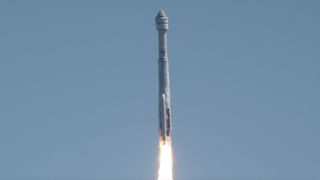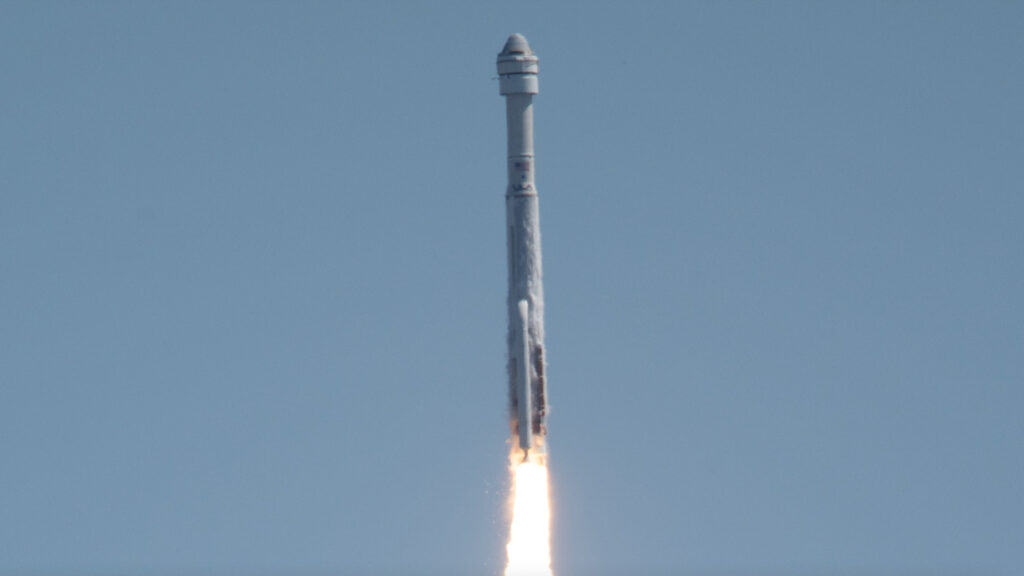
A United Launch Alliance Atlas V rocket with Boeing’s Starliner spacecraft aboard launches from Space Launch Complex 41 at Cape Canaveral Space Force Station, Wednesday, June 5, 2024, in Florida.
(Image credit: NASA/Joel Kowsky)
NASA, Boeing and United Launch Alliance (ULA) celebrated the historic launch of a second commercial crew spacecraft with astronauts today (June 5).
Boeing’s Starliner headed toward the International Space Station (ISS) today at 10:52 a.m. EDT (1452 GMT) with two NASA astronauts and former U.S. Navy test pilots on board: Butch Wilmore and Suni Williams. The duo made the record books not only as the first humans to ride Starliner, but also the first to launch atop ULA’s veteran Atlas V rocket.
“This is a special moment. It’s another one of those great markers in history,” NASA Administrator Bill Nelson said during a post-launch press conference today at Kennedy Space Center in Florida, near the launch site, Cape Canaveral Space Force Station.
“What NASA does is hard,” Nelson added. “Spaceflight is hard, but it’s worth doing.”
Related: I flew Boeing’s Starliner spacecraft in 4 different simulators. Here’s what I learned (video, photos)
Today’s launch marked the first time astronauts have left Earth from Cape Canaveral Space Force Station (or its many previous incarnations, which included Cape Kennedy Air Force Station and Cape Canaveral Air Force Station) since Apollo 7 in 1968. But more will likely follow in its footsteps soon.
The agency’s other commercial crew vendor, SpaceX, has already sent astronauts to space multiple times, first notching this milestone four years ago. SpaceX’s Crew Dragon, which built off the company’s successful cargo Dragon design, carried its first astronauts to space on a test flight in May 2020. Boeing, working with a new spacecraft, needed extra time to achieve the same thing.
Breaking space news, the latest updates on rocket launches, skywatching events and more!
Starliner’s first uncrewed test flight, in December 2019, suffered several software glitches that kept the spacecraft in the wrong orbit, unable to reach the ISS. The second uncrewed effort, which launched in May 2022, was successful: Starliner arrived at the ISS safely. Yet the newly launched astronaut mission, known as Crew Flight Test (CFT), faced new delays in 2023 after significant issues were found with Starliner’s parachute system and wiring (much of which was wrapped in flammable tape); these necessitated fixes, which took time.
Several other, more minor issues cropped up right before launch. CFT was supposed to get off the ground on May 6, but the team called that try off about two hours before launch after noticing a misbehaving valve in the Atlas V’s upper stage. ULA decided to replace the valve, which pushed the next try back to May 17. But then teams noticed a slight helium leak in one of Starliner’s reaction-control thrusters, which delayed things further. Ultimately, NASA, Boeing and ULA deemed the helium leak a minor issue and cleared CFT for launch on June 1. That try, however, was aborted just minutes before liftoff thanks to faulty ground equipment, pushing liftoff back to today.
“I know it’s really easy to lose patience as you’re waiting for launches to happen,” Ken Bowersox, associate administrator for NASA’s Space Operations Mission Directorate, said during today’s press conference. “But, as I said before, good things are worth waiting for.”
The focus of the CFT team is now on making sure Wilmore and Williams safely reach the ISS while testing key systems along the way. The duo will do some manual flying, for example, to get a feel for Starliner’s various systems.
Wilmore and Williams are “going to test this thing from izzard to gizzard, and they’re going to certify it for a rotational basis to send crew to the International Space Station,” Nelson said. (“Izzard,” in case you were wondering, is another word for the letter “z.”)
If all goes according to plan, Starliner will dock autonomously with the orbiting facility tomorrow (June 6) around 12:15 p.m. EDT (1615 GMT), a milestone that you can watch live here at Space.com.
Assuming the roughly 10-day-long CFT goes as planned and the mission meets all major objectives, Boeing’s first operational mission, Starliner-1, is scheduled for no earlier than 2025. That coming mission’s commander, NASA astronaut Mike Fincke, was backup on CFT, while mission specialist and Canadian Space Agency astronaut Josh Kutryk worked ascent as capcom (capsule communicator). Also on board Starliner-1 will be NASA’s Scott Tingle.
Keeping the Starliner-1 crew tightly integrated with CFT was a key goal in training, to smooth the flow between the missions as much as possible, Boeing and NASA have emphasized, as the ISS seeks to welcome U.S.-led crews every six months. The goal is for Dragon and Starliner to alternate launch opportunities.
Russia likely will not fly a cosmonaut aboard Starliner-1, as the country is waiting for more data on the spacecraft, NASA officials said in a press conference on May 3. How that will affect integrated crews in the future remains to be seen, as NASA plans to continue flying its astronauts aboard Russia’s Soyuz spacecraft for backup and policy reasons.
Boeing is expected to fly six or seven operational Starliner crews until the planned retirement of ISS in 2030, although it is possible Starliner will continue to serve the agency, helping NASA astronauts get to and from commercial space stations planned in the next decade.
Join our Space Forums to keep talking space on the latest missions, night sky and more! And if you have a news tip, correction or comment, let us know at: community@space.com.
Elizabeth Howell (she/her), Ph.D., is a staff writer in the spaceflight channel since 2022 covering diversity, education and gaming as well. She was contributing writer for Space.com for 10 years before joining full-time. Elizabeth’s reporting includes multiple exclusives with the White House and Office of the Vice-President of the United States, an exclusive conversation with aspiring space tourist (and NSYNC bassist) Lance Bass, speaking several times with the International Space Station, witnessing five human spaceflight launches on two continents, flying parabolic, working inside a spacesuit, and participating in a simulated Mars mission. Her latest book, “Why Am I Taller?”, is co-written with astronaut Dave Williams. Elizabeth holds a Ph.D. and M.Sc. in Space Studies from the University of North Dakota, a Bachelor of Journalism from Canada’s Carleton University and a Bachelor of History from Canada’s Athabasca University. Elizabeth is also a post-secondary instructor in communications and science at several institutions since 2015; her experience includes developing and teaching an astronomy course at Canada’s Algonquin College (with Indigenous content as well) to more than 1,000 students since 2020. Elizabeth first got interested in space after watching the movie Apollo 13 in 1996, and still wants to be an astronaut someday. Mastodon: https://qoto.org/@howellspace
>>> Read full article>>>
Copyright for syndicated content belongs to the linked Source : Space.com – https://www.space.com/nasa-boeing-celebrate-1st-starliner-astronaut-launch
